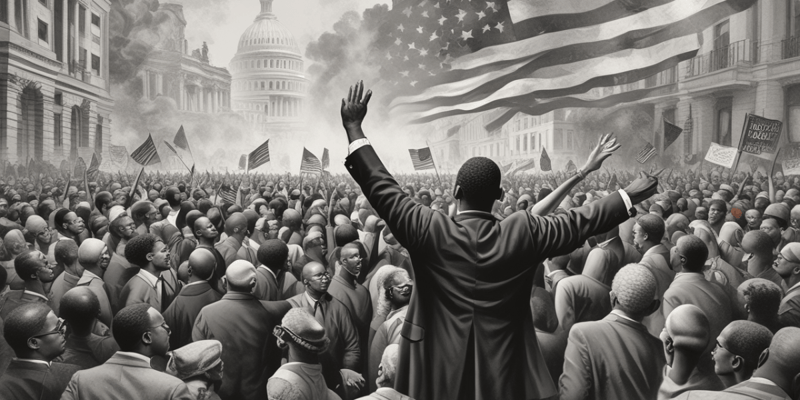15 Questions
What was the main goal of the Civil Rights Act of 1964?
To stop unfair treatment based on race, color, religion, or origin
What was the 'separate but equal' idea?
A law that allowed racial segregation
What did the Civil Rights Act of 1964 achieve in terms of voting rights?
It ensured fair voting rights, especially for Black Americans
What was the outcome of desegregation in the Civil Rights Act of 1964?
Integration of public places like restaurants and buses
What was outlawed in the workplace according to the Civil Rights Act of 1964?
Unfair treatment based on race, religion, or gender
What was a major outcome of the Civil Rights Act of 1964?
Fair treatment and equality for all
When was the Civil Rights Act passed?
1964
What was the main aim of the laws passed in the 1960s?
To make things fairer for everyone
What is an example of a place that was desegregated?
Restaurants and buses
What was the main focus of the Voting Rights Act of 1965?
Voting rights, especially for Black Americans
What was the main purpose of the Voting Rights Act of 1965?
To ensure fair voting practices and eliminate discriminatory rules
Which of the following was a key aspect of the Voting Rights Act of 1965?
Providing language assistance for voters
What was the impact of the Civil Rights Acts of the 1960s on the world?
They inspired movements for equality and fairness
What did the Civil Rights Act of 1964 ensure?
Fairness in employment
What was the goal of the Civil Rights Acts of the 1960s?
To ensure fair treatment and opportunities for all
Study Notes
Civil Rights Act of 1964
- The Civil Rights Act of 1964 was a landmark law that aimed to end unfair treatment based on race, color, religion, or national origin.
- It made it illegal to have separate places for different races, ending the 'separate but equal' idea.
- The Act ensured fairness in voting by making discriminatory practices illegal, especially for Black Americans who were often not allowed to vote.
- It helped make sure everyone had a say in how things were run.
- The Act also led to desegregation, making it illegal for places like restaurants and buses to separate people based on their race.
- Employment fairness laws ensured equal opportunities for all individuals, outlawing unfair treatment at work based on race, religion, or gender.
Voting Rights Act of 1965
- The Voting Rights Act of 1965 was created to help Black Americans and others who were being stopped from voting, especially in the South.
- It made sure that unfair rules like literacy tests and poll taxes, which made it hard for some people to vote, were not allowed.
- The Act prohibited discriminatory rules that kept people from voting, helping more people have a fair chance to cast their vote.
- It also stopped places from making it harder for certain people to vote by requiring permission before changing their voting rules.
- In areas where people spoke different languages, the law made sure that everyone got the help they needed to vote.
The Power of People and Leaders
- The Civil Rights Act of 1964 and the Voting Rights Act of 1965 were made possible because of the hard work of both regular people and national leaders.
- People like Martin Luther King Jr., Malcolm X, and Rosa Parks worked hard to bring attention to the need for change.
- President Lyndon B. Johnson also played a big part by getting these laws passed.
Legacy and Challenges
- Even though these laws made a big difference, there are still challenges.
- Some parts of the laws have been challenged in court, and some people are still trying to make it hard for others to vote.
- We must keep working together to make sure everyone is treated fairly and has the same opportunities in our society.
Global Influence
- The impact of these laws was not only felt in the U.S. but also around the world.
- Movements for equality and fairness in other countries were inspired by the Civil Rights Movement in the U.S.
- This showed that working together can create positive change for everyone.
Learn about the landmark Civil Rights Act of 1964, a pivotal moment in American history that aimed to end unfair treatment based on race, color, religion, and more. Understand its significance and impact on society.
Make Your Own Quizzes and Flashcards
Convert your notes into interactive study material.




